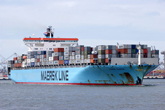Maersk Line is increasing capacity on a feeder service linking the west coasts of the Americas, according to research from ComPair Data.
The line is rotating in vessels nearly 50 percent larger on its WCCA service. By the end of June, the average vessel capacity on the service will have increased from 1,683 TEUs to 2,508 TEUs.
The rotation on the service, which is unchanged, is Los Angeles, Lazaro Cardena, Puerto Quetzal, Acajutla, Corinto, Puerto Caldera, Balboa, Puerto Caldera, Corinto, Acajutla, Puerto Quetzal, Lazara Cardenas, Manzanillo (MEX), Ensenada and Los Angeles.
Earlier this week, ComPair Data noted a three-ship intra-West Coast South America feeder from Maersk had been pulled, with the ships on that service moving to the line’s recently resurrected seasonal AC3 service between Asia and the West Coast of South America.
The arrival of the three vessels, which have 4,300 to 4,700 TEUs of capacity, has boosted the average capacity on the AC3 about 20 percent higher than Maersk said in an April announcement about the return of the AC3 “peak loader” service.
The AC3 has a rotation of Qingdao, Busan, Gwangyang, Yokohama, Lazaro Cardenas, Balboa, Buenaventura, Lazaro Cardenas and Qingdao. It’s operated with eight vessels with an average capacity of 4,850 TEUs.
American Shipper













